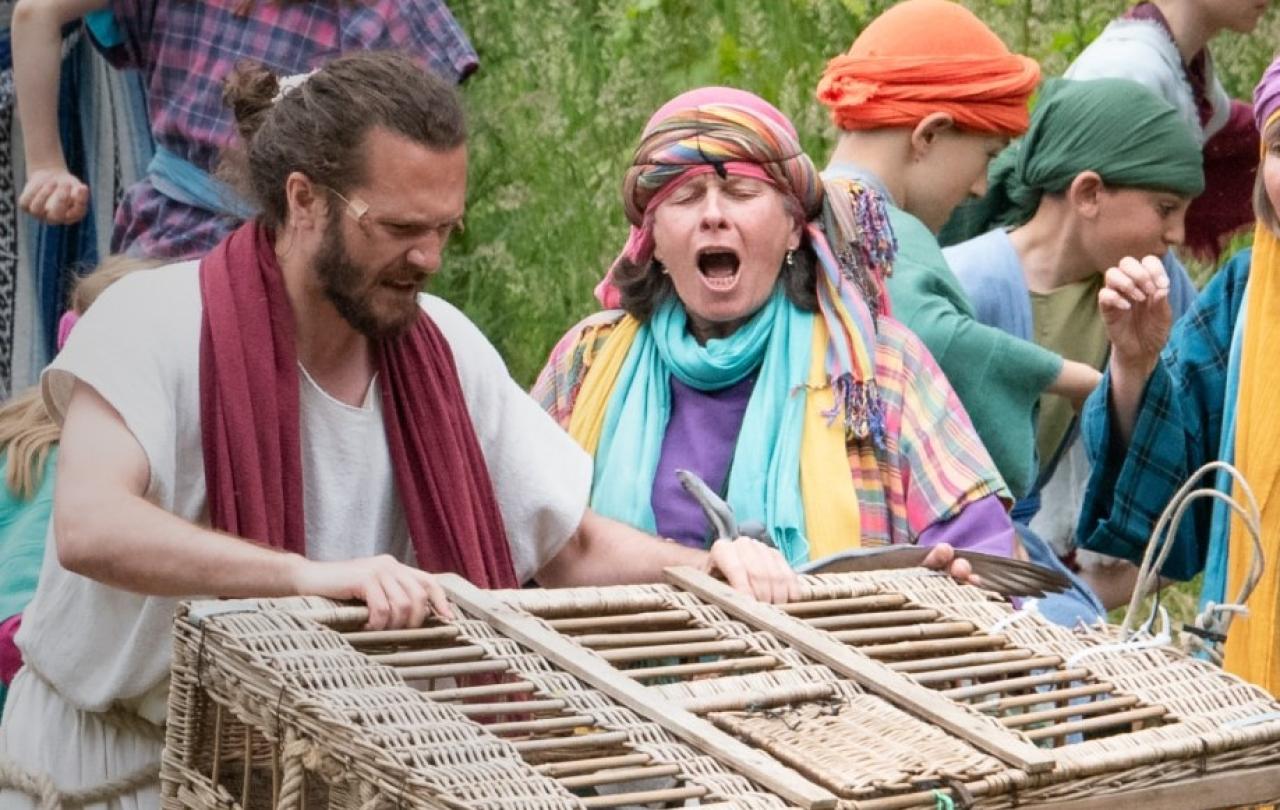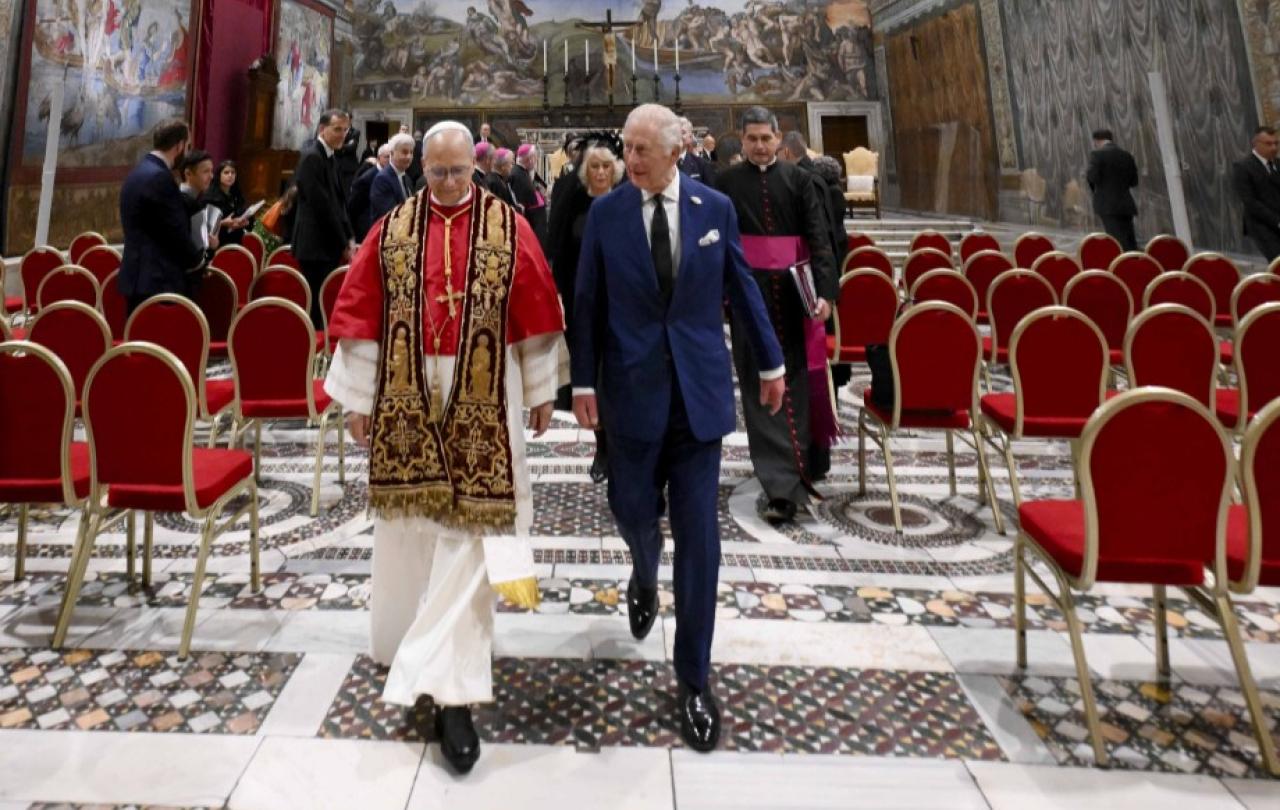
Were I to write a recipe for disaster, it would look something like this:
- Gather a large cast of mostly amateur volunteers and a few professionals
- Include everyone from a baby to a 90-year-old man, 1 donkey, 2 horses and a flock of sheep
- Create an outdoor venue with no seating and no shelter from the elements
- Welcome a mixed audience of around 1200 school children and the public every day for five days
- Present a five-hour dramatisation of the entire life of Jesus from 10am to 3.30pm
I am delighted to record that contrary to our assumptions, the above proved to be a remarkable recipe for triumph. Accompanied by my 18-year-old son who, as an actor and teenager, was sceptical, I’ll admit that expectations were not high as we embarked on a 2-hour drive to review The Life of Jesus 2025 at Wintershall Estate. The same drive home was rich in deeply moved and unexpected conversation about the incredible phenomenon just experienced.
Hearing superlatives from me is as unlikely an event as watching a rare desert flower bloom in a decade of drought. And yet, I have nothing else to offer in this case. I have viewed much professional and amateur theatre - Wintershall is like nothing I have witnessed before.
Perhaps what makes it so different is the intent of those who continue to create it. In 1989, Ann and Peter Hutley decided to open their beautiful estate to visitors interested in hearing about the life of Jesus. They began with a nativity in their new barn before Peter wrote a longer script for the millennium celebrations about Jesus’ ministry. It is tangible in the air that this is a monumental work of love and passion not profit-making.
On arriving, we met Ann and her daughter, Charlotte, who has taken over the enormous responsibilities as Wintershall’s producer. With consistent warmth, welcome and energy, Charlotte took us to join the cast as they received exacting professional notes from the director, Ashley Herman. She invited us to join hands with the cast in prayer. ‘No questions asked, it doesn’t matter what you believe, join hands and pray with us. Everyone is welcome here!’ she said. This is the truth about Wintershall in a sentence.
As a teacher of 23 years, I am sorry to admit that I had never heard of Wintershall. I would likely have baulked had someone suggested that I take my class on a daytrip of this format. My assumption would have been that they would hate it, they would be hot, bothered and bored, and I would be very stressed as a result. How foolish am I!
We visited on a day when the audience consisted of roughly 700 captivated school pupils, ranging from 7 – 18 years, and 300 members of the public. The previous few days had been exclusively for schools and had welcomed in the region of 1,200 pupils on each day. Looking for honest opinions, I asked an adult sat near me why she had brought her class. ‘Oh, I’m not a teacher,’ she said, ‘I volunteer to come on this trip every year because it’s the best thing I’ve ever seen. It just gets better and better!’ Clearly my prejudice was misplaced, and this is the very important issue.
My years in education mean that I have watched far too many five-year-olds in wonky tea towels, shouting at an inn keeper while the audience laughs. The life of Jesus has taken on a twee familiarity akin to Jack and The Beanstalk or Cinderella. It has become the stuff of folklore and fairytale when it is anything but. We have distorted it from the contemporaneous, historical recount that it is and Wintershall magnificently sets this straight.
Regardless of faith or belief, there is great damage done in forgetting to view history as reality. Those who work in schools and churches must remember that today’s children perceive the millennium celebrations as ancient history. They cannot fathom time outside of their own existence. All stories from the Egyptians to Princess Diana seem to them to be works of fiction because they must be imagined. Test this, as I have done, by asking them about a recently retired Roger Federer and observe their blank faces!
Even for me and my son, there came a meaningful realisation that this is not merely an all-too-familiar children’s story retold every year at Easter and Christmas. This is the biography of a man whose contemporaries were prepared to die in order to record the naturally inexplicable things that they saw him do. This first lands around 15 minutes into Act One when Wintershall presents Herod’s slaughtering of the children as the horrific and barbaric act that it was, with none of the usual soft-soap. Not gory or gratuitous in any way, it hits hard, just as it should, since, as Charlotte passionately reminded me, this is still happening in the world today! The same hit came from the disturbing noises made by the man suffering from demons, the size of the rocks about to be hurled at the woman accused of adultery and the often-omitted audible gasping of three men dying by crucifixion. These should not be benign imaginings, they are barbaric and torturous reality, and we do humanity no favours in desensitising ourselves.
Wintershall is clear that their production is for those aged seven and above because this is no fairytale. I would argue that this is precisely why they are able to keep children captivated through five hours of intense viewing. They have achieved the perfect balance of hard-hitting realism and enjoyment.
After stretching your legs, Act Two is simply glorious. We forget that Jesus’ ministry took the form of a pilgrimage delivered while walking with people in nature. He spoke on paths, hillsides and lakes which Wintershall authentically recreates. There is nothing to match the experience of sitting on a hillside next to a lake as the character of Jesus delivers the Sermon on The Mount whilst looking you straight in the eye. For the first time, I inwardly understood how a small number of loaves could literally feed a very large crowd because I experienced it first-hand. Quite simply, without needing to be told, you share. You break bread to ensure that those beside you have some and, in so doing, realise that there was always enough for everyone. This precious memory will endure as reality, not magic.
Act Four depicts the crucifixion. Seeing is believing. Again, this stuff of children’s stories is anything but. The logistics of this scene are extraordinarily well executed, and, for the first time, I was struck by the gasping of these men as they spoke. This was no polite conversation about meeting in paradise, these were their final words during their slow and painful death. The act is completed by the inexplicable and somewhat mystical reappearance of the risen Jesus in a different location beside us. I still have no idea how they did it, but it impacted powerfully.
So, what then were the negatives? Any trustworthy review must be balanced.
"There is nothing I have ever seen that I have more wanted to be a part of. Compared with this, I have never seen anything more meaningful."
Remember here my aversion to praise and my teenage son’s initial scepticism. Remember this seeming recipe for disaster and my remit to look critically.
After digging deep, we came up with two very minor concerns that are, in truth, little more than a matter of opinion or preference.
The first relates to the Angel Gabriel. In a production that so brilliantly undoes the fictionalisation of this biography, one could argue for a more nuanced representation of this angel. Perhaps not a female wearing the sparkly halo and white wings that fits with the wonky tea towels in school halls. Perhaps the name of Gabriel is sufficiently recognisable to permit something a little more daring?
The second relates to Act Three. Undoubtedly, the vibrant warmth, variety and personally immersive nature of Act Two makes it a very hard act to follow. Act Three is disadvantaged from the outset by occupying what we teachers know to be toughest gig of the day - that slot immediately following lunch. There is usually some social altercation to sort, attention needing to be refocused, and blood sugar levels fluctuating left, right and centre. At this time of natural siesta, you either accept a lull or bring your largest dose of entertainment. In this case, Jesus enters Jerusalem, overturns the tables in the temple, heals a leper, is betrayed by Judas, prays in Gethsemane, is arrested and tried before Pilate. Essential but not exceptionally entertaining, as the story goes. At around the 60-minute mark in, Jesus is stripped and whipped causing the children around me to literally sit up again and re-engage before Act Four. Perhaps, on reflection as I write, this is just as it should be.
And that is it, the sum of my critique. Believe me, my expectations are unforgivingly high; I struggle booking a holiday because the likelihood is that I will be disappointed. If there were critique to deliver, then deliver it I would.
To the contrary, it is unusually delightful to leave somewhere with the desire to do everything in my power to support a truly exemplary endeavour. It is to my detriment that I have been so ignorant of Wintershall for the last 25 years; I regret the thousands of children that I did not ever take to see this exceptional phenomenon.
I urge you to do better than me, to make up for my short fall.
Go!
Take everyone you can!
Make the journey!
Enjoy the day in glorious natural surroundings!
Show your pupils that even a flock of sheep can be perfectly well-behaved.
Rewrite the soppy fairytale as the gritty, historical biography that it is.
Replace the over-familiarity and wonky tea towels with a real-life experience in how to share what we have so that all might be fed.
Reimagine the mad magician as a man who loved the low, lost, and lonely, and will look you in the eye to remind you that you are blessed.
Reset the polite chat about paradise as the last conversation of a man gasping to share his love as he was killed for upsetting the authorities.
Remember that the infants are still being slaughtered and the women are still being stoned.
Reawaken to the fact that this is no fairytale. This is the message that the world needs.
As my son put it, ‘There is nothing I have ever seen that I have more wanted to be a part of. Compared with this, I have never seen anything more meaningful.’
Wintershall, one and all, you do not need to take a bow.
Stand tall and keep going.
What you are doing is superlatively necessary and remarkable!
Bravo!
Support Seen & Unseen
Since Spring 2023, our readers have enjoyed over 1,500 articles. All for free.
This is made possible through the generosity of our amazing community of supporters.
If you enjoy Seen & Unseen, would you consider making a gift towards our work?
Do so by joining Behind The Seen. Alongside other benefits, you’ll receive an extra fortnightly email from me sharing my reading and reflections on the ideas that are shaping our times.
Graham Tomlin
Editor-in-Chief





